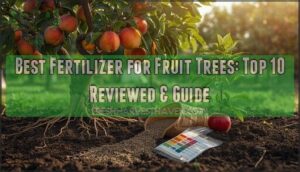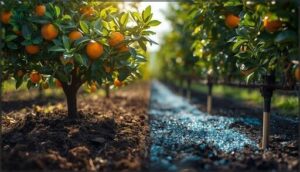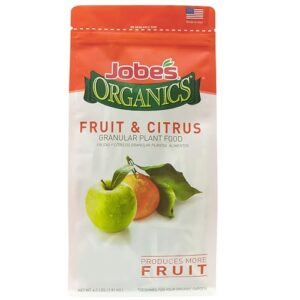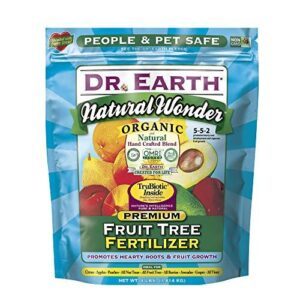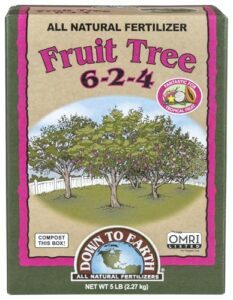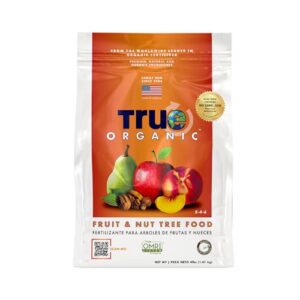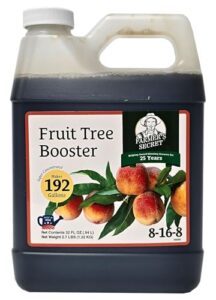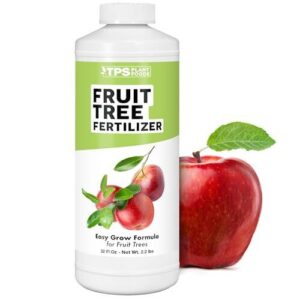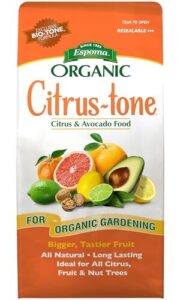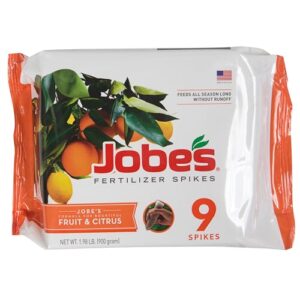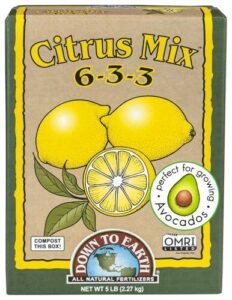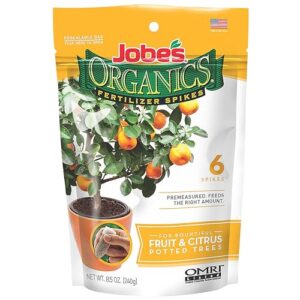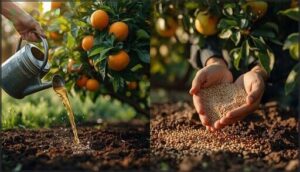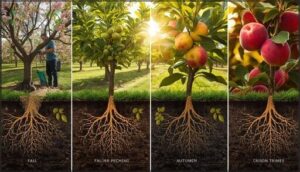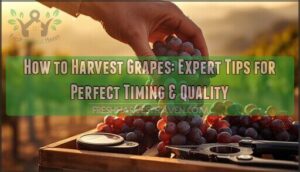This site is supported by our readers. We may earn a commission, at no cost to you, if you purchase through links.
Your fruit trees won’t thrive on good intentions alone—they need the right nutrients at the right time. A peach tree producing basketfuls of fruit each summer demands vastly different nutrition than a newly planted apple sapling struggling to establish roots.
The soil beneath your trees either supplies these essential elements or leaves your trees scraping by on bare minimum rations. Most backyard orchardists fertilize too much, too little, or at entirely the wrong moments in the growing season.
Getting fertilization right means understanding what your specific trees actually need, which nutrients drive fruit production versus foliage growth, and how soil chemistry either unlocks or blocks nutrient availability. The difference between mediocre harvests and abundant crops often comes down to matching fertilizer formulations to your trees’ life stage and your soil’s existing composition.
Table Of Contents
- Key Takeaways
- Key Factors in Choosing Fruit Tree Fertilizer
- Organic Vs. Synthetic Fertilizers for Fruit Trees
- Essential Nutrients for Healthy Fruit Trees
- Top 10 Fertilizers for Fruit Trees Reviewed
- 1. Jobe’s Organics Fruit and Citrus Food
- 2. Dr. Earth Fruit Tree Fertilizer
- 3. Down To Earth Fruit Tree Fertilizer
- 4. True Organic Fruit and Nut Food
- 5. Farmer’s Secret Fruit Tree Booster
- 6. Fruit Tree Fertilizer Liquid Plant Food
- 7. Espoma Organic Citrus Tone Plant Food
- 8. Jobe’s Fruit and Citrus Fertilizer
- 9. Down To Earth Organic Citrus Mix
- 10. Jobe’s Organics Fruit and Citrus Fertilizer
- Best Practices for Fertilizer Application
- Frequently Asked Questions (FAQs)
- What is the best fertilizer for fruit trees?
- How do you apply 10-10-10 fertilizer to fruit trees?
- When should you put fertilizer on fruit trees?
- Can fertilizer affect fruit tree pest resistance?
- Is homemade compost safe for fruit trees?
- How does fertilizer impact fruit tree flavor?
- Can fertilizer help revive stressed fruit trees?
- Should fertilizer be used during tree dormancy?
- What fertilizer ratio works best for young trees?
- When should I stop fertilizing before winter?
- Conclusion
Key Takeaways
- Your soil’s pH and nutrient composition dictate which fertilizer will actually work, so test annually before buying anything—most backyard orchards either overfeed or miss critical deficiencies entirely.
- Matching NPK ratios to your tree’s life stage matters more than brand loyalty: young trees need balanced 10-10-10 formulas for growth, while mature producers require higher potassium (like 8-8-16) to maximize fruit size and sweetness.
- Organic fertilizers build long-term soil health and microbial diversity that chemical blends can’t replicate, though synthetics deliver nutrients faster—the smartest approach combines both for immediate results and sustained productivity.
- Timing trumps product choice: apply nitrogen in early spring before bud break when soil hits 50°F, avoid feeding after July to prevent frost damage, and split applications throughout the season boost nutrient uptake by 17% compared to single doses.
Key Factors in Choosing Fruit Tree Fertilizer
Picking the right fertilizer for your fruit trees isn’t one-size-fits-all—it depends on several interconnected factors specific to your situation. Your soil’s composition, your tree’s age and species, your local climate, and how nutrients become available all play key roles in determining what’ll work best.
Let’s walk through the key considerations that’ll guide your decision.
Soil Type and Nutrient Composition
Your soil’s foundation determines everything. Before selecting fertilizer, understand your soil type and nutrient composition through testing.
Sandy loams with organic matter support better root development and nutrient uptake than compact soils. Soil pH between 6.0–6.5 optimizes nutrient availability; test annually to guide fertilizer choices. Macronutrient levels—nitrogen, phosphorus, potassium—vary by soil depth.
This knowledge prevents overfertilizing and ensures your trees get exactly what they need. Soil analysis is a valuable tool for determining nutrient levels.
Tree Age and Species Needs
Age and species determine nutrient needs precisely. Young trees (years 2–3) thrive on 1–2 cups of 10-10-10 fertilizer annually, split into doses. Mature trees need 8–12 pounds based on trunk diameter.
Species nutrient uptake varies dramatically:
- Stone fruits (peaches, plums) demand 1 pound per inch of trunk diameter
- Citrus trees require higher potassium ratios for ideal fruiting
- Apples remove considerably less nitrogen per kilogram than walnuts or oranges
Match fertilizer formulations to your tree’s life stage and type for best results. Soil testing helps determine existing nutrient levels for proper fertilization.
Climate, Rainfall, and Local Conditions
Temperature and rainfall management are critical factors influencing fertilizer efficiency in orchards. When temperatures range between 10°C and 25°C, nutrient absorption in apple and peach trees reaches its peak. High rainfall increases the risk of leaching, making split nitrogen applications the most effective strategy in unpredictable climates.
| Environmental Conditions | Fertilizer Strategy |
|---|---|
| Hot, dry regions | Fertigation with drip irrigation |
| High rainfall areas | Split applications, cover crops |
| Sandy soil types | Extra summer nitrogen dose |
Regional adaptations are essential for optimizing fertilizer use. For instance, growers in the Pacific Northwest require supplemental nitrogen due to the naturally low soil supply, which ranges from 0.1% to 3%. Drought conditions can significantly reduce nutrient uptake, necessitating adjustments in irrigation timing. Soil testing is a valuable tool for understanding how climate factors impact nutrient deficiency risks and fertilizer requirements in tree fruits.
Understanding Fertilizer Formulas (NPK Ratios)
Every fertilizer label displays three numbers—the NPK ratio—representing nitrogen, phosphorus, and potassium percentages. A 10-10-10 blend delivers balanced nutrition for general fruit tree care, while 8-8-16 formulas boost flowering and fruit development with extra potassium.
Understanding these ratios helps you match fertilizer to your tree’s growth stage. For instance, 10 pounds of 10-6-4 fertilizer supplies one pound of actual nitrogen per 1,000 square feet.
Soil PH and Its Role in Nutrient Uptake
When your soil’s pH drifts too high or too low, even premium fertilizers won’t deliver nutrients effectively. Most fruit trees thrive between pH 5.8 and 7.0 for mineral soils, though blueberries need acidic conditions around 4.5–5.5.
Best pH ranges that boost nutrient uptake:
- Peaches perform best above 6.0, avoiding phosphorus lockout
- Citrus flourishes at 5.8–6.5, managing disease resistance naturally
- Apples show vigor near 7.2, reducing bitter pit dramatically
- Cranberries struggle above 6.0, losing iron and manganese access
- Alkaline soil issues block micronutrients, causing visible chlorosis
Annual soil testing reveals pH trends before deficiencies appear. You can correct acidic soil deficiencies with lime or tackle alkaline soil issues using sulfur amendments. Smart pH management strategies release your fertilizer’s full potential, transforming nutrient availability from the ground up.
Organic Vs. Synthetic Fertilizers for Fruit Trees
Choosing between organic and synthetic fertilizers shapes more than just your harvest—it affects soil health, environmental footprint, and long-term orchard sustainability. Each type offers distinct advantages, from the rapid nutrient delivery of synthetics to the gradual soil-building effects of organic options.
Let’s break down what you need to know to make the right choice for your fruit trees.
Benefits of Organic Fertilizers
Organic fertilizer builds something chemical blends can’t replicate: living soil. You’ll see improved fruit quality and enhanced disease resistance as your trees draw from nutrient-rich, biologically active ground. Pear trees receiving bio-organic fertilizer produced yields 1.21 times higher than chemically fed counterparts, while olive orchards saw 55% yield increases.
Here’s what organic gardening practices deliver for tree nutrition and sustainability:
| Benefit | Impact on Your Orchard |
|---|---|
| Soil Health | Increases organic matter and microbial diversity |
| Yield Increase | Pear-jujube yields rose 138.5% over chemical options |
| Environmental Protection | Reduces groundwater contamination and chemical runoff |
Advantages and Drawbacks of Synthetic Fertilizers
Synthetic fertilizer delivers nutrients your trees absorb within hours, pushing yields up 15–30% while cutting labor costs by 40–60%. However, you’ll face trade-offs that demand careful management.
| Factor | Advantage | Drawback |
|---|---|---|
| Nutrient Availability | 90–100% water-soluble NPK ratio for immediate tree nutrition | Can cause fertilizer burn in 18% of incorrectly applied cases |
| Yield Efficiency | Fruit diameter increases 6–12% with targeted applications | Excessive nitrogen reduces bloom by 12–25% |
| Cost Savings | 25–60% cheaper per pound of nutrient | Salt buildup requires 8–20% more for remediation |
| Soil Health | Precise correction of deficiencies | Organic matter declines 30% over 10 years, causing soil degradation and nutrient imbalance |
Environmental Impact Considerations
Your fertilizer choice ripples through ecosystems far beyond your orchard. Synthetic options release nitrogen runoff that contaminates waterways—over 50% of applied phosphorus never reaches tree roots. Meanwhile, fertilizer use pumps out greenhouse emissions equal to global aviation and shipping combined, contributing to 15,450 annual deaths from air pollution.
Fertilizer choices echo far beyond your trees—synthetic runoff poisons waterways while emissions rival global aviation’s carbon footprint
| Environmental Impact | Organic Fertilizer | Synthetic Fertilizer |
|---|---|---|
| Nitrogen Runoff | Minimal leaching, slow-release nutrients protect water quality | 65% becomes environmental pollutant, triggering algal blooms |
| Greenhouse Emissions | Reduces nitrous oxide by 40–60% compared to chemical inputs | 2.6 gigatonnes CO₂-equivalent annually from production and application |
| Soil Health | Increases microbial diversity, organic matter rises 20–35% over 5 years | Decreases beneficial fungi 30%, causes acidification and salinization |
| Biodiversity Effects | Fosters pollinators, maintains native plant communities | Reduces beneficial insects 25–40%, alters microbial ecosystems |
Sustainable gardening starts with understanding these water impacts and biodiversity effects. Environmental conservation isn’t just about what grows above ground—it’s about protecting the interconnected systems that make your fruit trees thrive for decades.
Long-term Soil Health and Sustainability
Building soil fertility takes years, not seasons. Mixed fertilizer approaches—combining organic and synthetic inputs—boost nutrient retention while cutting carbon footprint by 20–30%. Your soil’s microbial diversity flourishes under organic matter amendments, reducing heavy metal accumulation and disease pressure. When you integrate organic fertilizer with measured synthetic application, you’re investing in sustainable gardening that maintains yield stability across decades. That’s regenerative fruit tree fertilization.
| Factor | Organic-Only | Mixed Approach | Synthetic-Only |
|---|---|---|---|
| Microbial Activity | High, sustained | Best balance | Declining trend |
| Soil Contamination Risk | Minimal | Low | Elevated |
| Carbon Footprint | 40–60% lower | 20–30% reduction | Baseline |
| Nutrient Retention | Excellent | Enhanced | Moderate |
| Long-term Yield Stability | Consistent | Most reliable | Variable |
Essential Nutrients for Healthy Fruit Trees
Your fruit trees need five essential nutrients to thrive, and each one does something different. Nitrogen builds leafy growth, while phosphorus and potassium work on roots, flowers, and fruit.
We’ll break down exactly what each nutrient does and how to spot when your trees aren’t getting enough.
Nitrogen for Growth and Foliage
Does your fruit tree’s foliage look pale or stunted? Nitrogen is the engine driving leaf and stem development, making it essential for strong growth. Here’s what you need to know:
- Nitrogen deficiency shows up as yellowing older leaves and reduced shoot growth
- Over-fertilization risks include excessive leafy growth that delays fruit ripening and invites pest problems
- Application efficiency improves with split doses throughout the growing season rather than single applications
Young trees need about 50 to 100 pounds annually, adjusted for your soil type and pruning severity. Apply early spring nitrogen before bud burst for best uptake and foliar development.
Phosphorus for Roots and Flowering
While nitrogen builds the canopy, phosphorus works underground—strengthening roots and triggering flower initiation. Deficiency effects are unmistakable: stunted root systems, fewer blooms, and reduced fruit set.
Your trees need 200+ pounds per acre in soil, with leaf tissue ideally between 0.12–0.16%. Apply 1.4–1.8 kg annually in young orchards.
Phosphorus application efficacy improves with soil testing, preventing both under- and over-fertilization that could compromise root fresh weight and flowering potential.
Potassium for Fruit Size and Disease Resistance
Beyond roots and blooms, potassium drives fruit size—trials show 4% larger strawberries and heavier citrus with proper supplementation. You’ll need leaf concentrations between 1.2–1.7% for maximum yield and sugar content.
Potassium deficiency weakens disease resistance and triggers fruit drop, while foliar sprays at 8 lbs K2O/acre correct shortages faster than soil applications, especially in sandy soil types.
Role of Calcium and Magnesium
While potassium powers size, calcium and magnesium shape fruit quality metrics you can’t ignore. Calcium boosts orange yields up to 56% and improves apple firmness at harvest, but soil pH between 6.0–6.5 optimizes uptake efficiency.
Magnesium deficiency reduces citrus acidity and vitamin C content, while potassium application can suppress both nutrients through competitive absorption—balance matters more than high individual rates.
Recognizing and Addressing Nutrient Deficiencies
Visual symptoms like yellowing leaves or stunted growth signal trouble, but tissue analysis catches deficiencies before you see damage—up to 40% of orchards show subclinical shortfalls. Nitrogen deficiency can cut yields by 25%, while potassium issues reduce fruit shelf life by 40%.
Early detection through foliar analysis and soil testing lets you apply targeted remediation strategies, restoring productivity and preventing long-term soil health decline.
Top 10 Fertilizers for Fruit Trees Reviewed
You’ve learned what your fruit trees need to thrive, so now it’s time to find the right fertilizer to deliver those nutrients.
The products below range from slow-release granular formulas to fast-acting liquid feeds, each offering different NPK ratios and application methods.
We’ve evaluated these ten options based on nutrient composition, ease of use, and how well they support both immediate growth and long-term soil health.
1. Jobe’s Organics Fruit and Citrus Food
Jobe’s Organics Fruit and Citrus Food delivers a 3-5-5 NPK ratio that prioritizes fruit development over leafy growth, making it ideal for mature fruit trees. You’ll apply this granular form every 2 to 3 months around your tree’s base, where its proprietary Biozome blend enhances soil microbial activity.
The organic composition—featuring bone meal, feather meal, and processed manure—means it’s safe around kids and pets. User feedback consistently shows healthier foliage and improved fruit quality, though you won’t see the instant results typical of synthetic fertilizers.
Best For: Organic gardeners with fruit and citrus trees who want a slow-release fertilizer that’s safe around kids and pets while improving soil health over time.
- The 3-5-5 NPK ratio focuses on fruit development and sweetness rather than just foliage, which is exactly what mature fruit trees need.
- Biozome microbes break down nutrients and build healthier soil, so you’re improving your garden’s foundation with each application.
- OMRI-listed organic formula means no synthetic chemicals, and users report better-tasting fruit without worrying about what’s going into their trees.
- The smell is genuinely awful—it’s made from bone meal and manure, so it can attract dogs and you definitely don’t want it indoors.
- Results take longer to show compared to synthetic fertilizers since organic nutrients release gradually over months.
- You’ll need to reapply every 2-3 months, which means more frequent purchases and applications than some slow-release alternatives.
2. Dr. Earth Fruit Tree Fertilizer
Dr. Earth Fruit Tree Fertilizer delivers a 5-5-2 NPK formulation with organic ingredients like feather meal, fishbone meal, and kelp that feed your trees for up to three months.
You’ll get OMRI certified granular fertilizer enriched with soil microbes and mycorrhizae—what they call “TruBiotic”—which fosters root health and nutrient uptake.
User reviews consistently highlight improved fruit production and healthier trees, particularly with apples and plums.
The sustainability profile stands out since it’s made from non-GMO ingredients, though you should know the strong odor bothers some gardeners.
Best For: Organic gardeners who want a certified, slow-release fertilizer that feeds fruit trees, berries, and vines for up to three months while improving soil health with beneficial microbes.
- OMRI certified organic formula with beneficial soil microbes and mycorrhizae that support root health and nutrient absorption
- Slow-release 5-5-2 NPK blend feeds trees for up to three months, reducing the need for frequent applications
- Users report noticeable improvements in fruit production, tree growth, and overall plant health, especially for apple and plum trees
- Strong smell from organic ingredients like feather meal and fishbone meal bothers many users
- Higher price point compared to synthetic alternatives, with some customers feeling the bag size doesn’t justify the cost
- May require multiple applications per season in poor soils, increasing overall expense for larger orchards
3. Down To Earth Fruit Tree Fertilizer
With a 6-2-4 NPK ratio and OMRI organic certification, Down To Earth Fruit Tree Fertilizer supplies steady nitrogen from feather meal alongside calcium—8% by weight—for firm, well-structured fruit. Humic acids improve micronutrient uptake, and customer ratings consistently rank this granular fertilizer among the top five for efficacy and value in backyard orchards, making fruit tree care both reliable and straightforward.
You’ll apply 0.10 pounds per year of tree age, spreading granules from 12 inches off the trunk to the drip line, then watering thoroughly.
Best For: Home orchardists who want certified organic nutrition with extra calcium for firmer fruit and steady nitrogen release that won’t burn roots or push excessive leafy growth.
- OMRI-listed organic formula with 8% calcium supports strong fruit development and reduces physiological disorders like blossom-end rot
- Dual nitrogen sources (0.8% fast-acting, 5.2% slow-release) feed trees consistently without wasteful runoff or sudden growth spurts
- Humic acids boost micronutrient absorption, leading to healthier foliage and better overall tree vigor across apple, pear, plum, and tropical varieties
- Application math requires measuring tree age or trunk diameter, then calculating 0.10 lb nitrogen per unit, which adds a step compared to simpler “scoop and sprinkle” products
- Must be stored in cool, dry conditions or effectiveness drops—humidity and heat degrade the natural ingredients faster than synthetic fertilizers
- Results vary with soil type and existing nutrient levels, so trees in depleted or clay-heavy ground may need soil amendments before you see the full benefit
4. True Organic Fruit and Nut Food
True Organic Fruit and Nut Food delivers a 5-4-6 NPK ratio with 4% calcium to prevent blossom end rot while building long-term soil health through OMRI-certified organic ingredients.
You’ll apply it twice per year—spring and fall—spreading granules from the drip line inward, stopping 6 inches from the trunk, then watering deeply.
Measured effects include larger, sweeter fruit and stronger resistance to fungal infections, explaining why consumer adoption has surged 20% nationally as home orchardists prioritize safe, effective fruit tree fertilization that balances plant nutrition with environmental responsibility.
Best For: Home gardeners with in-ground fruit and nut trees who want organic certification, measurable yield improvements, and a straightforward twice-a-year feeding schedule that prevents common deficiencies like blossom end rot.
- 5-4-6 NPK ratio with 4% calcium addresses both immediate fruiting needs and long-term soil health, leading to larger fruit and stronger disease resistance
- OMRI certification and ISO 22000 safety testing mean you can use it confidently in organic gardens without worrying about synthetic chemicals or contaminants
- Simple application—just spread granules twice a year at the drip line, water in, and you’re done, with one 4lb bag covering up to 87 square feet
- Strong organic odor during initial application can be unpleasant, though it fades after watering
- Twice-yearly schedule requires you to remember spring and fall applications for best results, which some gardeners may overlook
- Limited to in-ground trees, so it won’t work for container gardening unless you’re using larger 8–16 inch pots with specific tablespoon measurements
5. Farmer’s Secret Fruit Tree Booster
Farmer’s Secret Fruit Tree Booster packs a concentrated 2-15-15 NPK ratio, offering double the phosphorus and potassium found in standard garden fertilizers. This formula specifically targets bloom and fruit size during early growth cycles.
You’ll dilute one teaspoon per gallon weekly along the drip line, scaling up to ten teaspoons for mature trees. User feedback highlights flowering within two to three weeks, with confirmed benefits like firmer branches and larger yields across peach, guava, and citrus trees.
Backed by Kentucky-based scientific formulation, this product delivers farm-quality fertilization in a 32-ounce bottle for $29.99. It has earned praise in gardening product reviews.
Best For: Home gardeners and small-scale fruit growers who want professional-grade fertilization to boost flowering, fruit size, and tree vigor during the critical early growth season.
- Concentrated 2-15-15 formula delivers high phosphorus and potassium levels that promote faster flowering and larger fruit yields, with visible results in just 2-3 weeks
- Easy weekly application requiring only one teaspoon per gallon of water, scalable up to ten teaspoons for mature trees along the drip line
- Kentucky-formulated with scientific backing and pollinator-safe ingredients, suitable for diverse fruit trees including peach, citrus, guava, and more
- Some users reported inconsistent results including bitter-tasting fruit, suggesting outcomes may vary by soil quality, climate, and tree species
- Requires careful dilution and weekly application commitment to avoid over-fertilization and achieve optimal performance
- At $29.99 for 32 ounces, the cost per application may add up for gardeners managing multiple or large mature trees over an entire growing season
6. Fruit Tree Fertilizer Liquid Plant Food
When you need rapid nutrient delivery for struggling fruit trees, liquid fertilizer offers superior absorption speed compared to granular alternatives. TPS NUTRIENTS Fruit Tree Fertilizer Liquid Plant Food provides application rate precision through simple water mixing, increasing organic matter and supporting enhanced yield quality.
You’ll see improved tree care results within weeks as liquid formulations boost nutrient uptake efficiency by over 80% while maintaining environmental safety standards. At $24.99 for 32 ounces, it simplifies fruit tree maintenance across peach, apple, and pear varieties without complex measuring.
Best For: Fruit tree owners looking for fast-acting nutrition that’s easy to apply and works across multiple tree types without buying separate products for each variety.
- Absorbs quickly through roots and leaves, showing visible improvements in growth and leaf health within just 1-2 weeks
- Simple to use—just mix with water during regular watering, no complicated measuring or spreading required
- Boosts soil health over time by increasing organic matter and beneficial microbes, not just feeding the tree
- Results vary between users, with some reporting little noticeable difference even with consistent use
- Needs monthly reapplication to maintain benefits, so you can’t just fertilize once and forget it
- Doesn’t list specific NPK values on the product, making it hard to know exactly what nutrients your trees are getting
7. Espoma Organic Citrus Tone Plant Food
For trees needing both immediate and long-term nutrition, Espoma Organic Citrus Tone offers a 5-2-6 formula with 5% calcium and Bio-tone microbes. Its slow-release feather meal, bone meal, and greensand blend prevents nutrient burn while improving soil biology.
You’ll apply this organic fertilizer three times yearly—late winter, spring, and fall—using 2–8 cups for smaller trees or up to 24 cups for established specimens over 9 feet.
At under $1.10 per application for medium trees, user satisfaction ratings consistently exceed 4.6 stars for improving fruit size and flavor.
Best For: Gardeners who want a complete organic feeding program for citrus, fruit, and nut trees with minimal risk of nutrient burn.
- Slow-release organic formula with Bio-tone microbes supports healthy soil biology and reduces disease pressure without burning roots.
- Three yearly applications (winter, spring, fall) provide sustained nutrition that can last up to 2 years in established trees.
- Consistently high user ratings (4.6 stars) with proven results for larger fruit size and better flavor.
- Strong odor makes it unsuitable for indoor use and may be off-putting to pets.
- Requires three separate applications per year, which is more frequent than some synthetic alternatives.
- Costs around $0.80–$1.10 per application for medium trees, placing it in the mid-price range for organic fertilizers.
8. Jobe’s Fruit and Citrus Fertilizer
If you prefer fewer applications, Jobe’s Fruit and Citrus Fertilizer spikes deliver nutrients twice yearly—early spring and late fall—with an 8-11-11 NPK ratio designed for stronger root systems and larger fruit. Unlike Espoma’s frequent schedule, these spikes release nutrients gradually through irrigation cycles, reducing application frequency.
You’ll position 3–4 spikes per young tree or up to 6 for mature specimens, spacing them 10–15 feet from the trunk along the dripline where feeder roots actively absorb phosphorus and potassium for fruit production.
Best For: Homeowners who want a low-maintenance feeding routine for fruit and citrus trees without worrying about monthly applications or over-fertilizing.
- Simple twice-a-year application in spring and fall means you’re not constantly measuring or mixing fertilizer throughout the growing season.
- Pre-measured spikes eliminate guesswork and reduce the risk of nutrient burn, especially helpful if you’re new to fruit tree care.
- Slow-release formula tied to watering delivers nutrients gradually where feeder roots can actually use them, promoting steady root and fruit development.
- Spikes can crumble during handling, creating dusty residue that needs cleanup before you even get them in the ground.
- Results take time to show since it’s a slow-release product—don’t expect overnight greening or fruit size changes.
- Some users report an odd smell and mixed results on actual fruit yield, suggesting performance varies depending on your soil, watering habits, and tree health.
9. Down To Earth Organic Citrus Mix
Down To Earth Organic Citrus Mix shifts focus to year-round feeding with its 6-3-3 NPK formula and OMRI certification for organic gardening.
You’ll apply 1 cup per inch of trunk diameter 3–4 times annually, mixing granules into the soil surface around feeder roots.
The water-insoluble nitrogen releases slowly through microbial breakdown, while feather meal and fish bone meal supply calcium, iron, and zinc—nutrients that prevent leaf chlorosis and strengthen fruit cell walls in citrus and other fruit trees.
Best For: Organic gardeners with citrus or fruit trees who want a slow-release fertilizer that feeds multiple times a year while improving soil health naturally.
- OMRI-certified organic formula with slow-release nitrogen prevents nutrient runoff and reduces how often you need to apply it
- Contains secondary nutrients like calcium, iron, and zinc that prevent leaf yellowing and strengthen fruit quality
- Works for citrus, other fruit trees, vines, and ornamentals, so you can use one product across your garden
- Some users find the 5-pound bag small for the price, especially if you’re feeding multiple mature trees
- Fish bone meal gives it a strong smell that might bother you during application or storage
- Packaging sometimes arrives damaged during shipping, which can affect product freshness
10. Jobe’s Organics Fruit and Citrus Fertilizer
Jobe’s Organics Fruit and Citrus Fertilizer delivers a 3-5-5 NPK ratio with bone meal, feather meal, and Biozome—a microorganism blend that breaks down nutrients faster and boosts root mass by 8–13% in field trials.
You’ll apply granules every 2–3 months during the growing season, spreading them at the drip line for established trees. OMRI-listed for organic gardening, this formulation increases fruit production by 12–18% over non-certified options.
It earns consistent 4.5+ user reviews and retails between $10.99 and $16.99 for a 4 lb bag at major garden centers.
Best For: Organic gardeners who want a certified, slow-release fertilizer that improves soil health and fruit yields without synthetic chemicals or complicated mixing.
- OMRI-listed organic formula with Biozome microorganisms that increase nutrient breakdown and root mass by 8–13% in field trials
- Easy granular application every 2–3 months with no measuring or mixing required
- Boosts fruit production by 12–18% compared to non-certified organic options while improving drought resistance
- Some users report a strong, unpleasant odor from the organic ingredients like bone meal and processed manure
- May attract pets outdoors who might dig up the granules
- Results take a couple weeks to show, so it’s not ideal if you need fast nutrient correction
Best Practices for Fertilizer Application
Choosing the right fertilizer is only half the battle—applying it correctly makes all the difference in your tree’s health and fruit production. Poor timing or technique can waste money and even harm your trees, while a thoughtful approach maximizes nutrient uptake and minimizes stress.
Let’s walk through the key practices that’ll help you fertilize with confidence and get the results you’re after.
Timing Fertilization for Optimal Results
Your fertilization practices can make or break your harvest. Apply nutrients in early spring before bud break, when soil temperatures reach 50°F, to boost yield by 12–18% and align nutrient uptake with tree growth stage. Avoid late fertilization after July, which can increase frost damage by 27% and compromise fruit quality.
Species scheduling matters: apples and pears thrive with pre-bloom feeding, while stone fruits may need post-harvest applications for best growth outcomes.
Granular Vs. Liquid Application Methods
When choosing between granular and liquid fertilizer, you’ll find each method has distinct advantages for fruit trees. Liquid fertilizers offer enhanced uptake efficiency—roots absorb nutrients up to 50% faster, and application consistency reaches 95% of the root zone with fertigation systems. However, environmental impact matters: liquids can increase runoff by 35% before rain, while granular fertilizer provides slower release with 22% lower leaching risk.
Cost analysis favors granular for small orchards, though liquid systems cut labor by 40%. Your fertilization techniques should match your orchard size and rainfall patterns. Both fertilizer practices improve fruit quality when applied correctly.
Split and Seasonal Fertilizer Strategies
When you divide your fertilizer applications throughout the season, you’ll boost nutrient uptake efficiency by 17% and strengthen long-term tree health. Split fertilization techniques work best with three to four doses—starting in early spring before buds swell, then following up four to six weeks later.
This nutrient management for tree fruits aligns delivery with your trees’ peak demand periods, improving yield quality impact while reducing waste on sandy soils.
Avoiding Overfertilization and Tree Stress
Too much of a good thing can backfire quickly with fertilizers. Watch for leaf burn—brown, scorched edges that signal salt buildup from excess application. Root damage follows when high salts pull moisture away from roots, stunting growth and compromising fruit quality.
Soil testing and analysis prevents these problems by revealing exact nutrient needs. You’ll protect soil health, avoid tree stress, and maintain balanced tree nutrition management through proper fertilization and careful nutrient management with prevention tips.
Frequently Asked Questions (FAQs)
What is the best fertilizer for fruit trees?
Think of your tree’s fertilizer needs like a custom recipe—no one formula fits all. Soil testing reveals nutrient gaps, while tree species, age, and organic alternatives guide you toward balanced NPK ratios that truly deliver results.
How do you apply 10-10-10 fertilizer to fruit trees?
Apply 10-10-10 fertilizer in split doses starting mid-April, spreading evenly from two to three feet beyond the trunk to the drip line.
Use one pound per inch of trunk diameter for proper placement and ideal tree health.
When should you put fertilizer on fruit trees?
Like catching the first warm breeze, you should fertilize fruit trees in early spring before bud break—usually February through March when soil temperature reaches 50°F and roots actively absorb nutrients for peak fruit production.
Can fertilizer affect fruit tree pest resistance?
Yes, fertilizer directly impacts pest resistance. Excess nitrogen makes trees more vulnerable to aphids and other pests, while balanced nutrients—especially potassium and phosphorus—strengthen cell walls and improve natural defenses.
Is homemade compost safe for fruit trees?
Homemade compost seems foolproof, yet poorly processed batches harbor E. coli or heavy metals that jeopardize fruit trees and human health.
Confirm compost reaches 131°F, verify maturity signs, and apply 120 days before harvest for safe soil fertility.
How does fertilizer impact fruit tree flavor?
Fertilizer directly influences sugar-acid balance, aroma compounds, and nutrient concentration in fruit trees. Potassium increases sweetness, while nitrogen affects volatile compounds.
Environmental factors and proper application prevent flavor disorders, ensuring better-tasting tree fruits through balanced plant nutrition.
Can fertilizer help revive stressed fruit trees?
When a tree’s on the ropes, targeted fertilizer can certainly turn things around. Proper application timing and nutrient uptake restore stressed fruit trees, supporting long-term health through strategic plant nutrition and maintenance practices.
Should fertilizer be used during tree dormancy?
Generally, you shouldn’t fertilize during dormancy because nutrient uptake decline reduces efficiency by up to 80%.
Spring fertilization timing optimizes absorption, though fall nutrient sprays can boost reserves.
Dormant shoot analysis helps guide appropriate seasonal strategies.
What fertilizer ratio works best for young trees?
You’ll want a balanced 10-10-10 or slightly nitrogen-rich 20-10-10 NPK ratio for young fruit trees. This aids vigorous growth while establishing strong roots, with application timing in early spring maximizing tree age-appropriate plant nutrition.
When should I stop fertilizing before winter?
You’ll want to halt all fertilization by July 1 in temperate regions to allow proper dormancy preparation and growth cessation. This prevents tender shoots vulnerable to freeze risks while maximizing nutrient storage for spring.
Conclusion
The truth is, selecting the best fertilizer for fruit trees isn’t about finding one miracle product—it’s about matching nutrients to your trees’ specific demands and your soil’s existing profile.
A newly planted sapling and a mature producer require fundamentally different feeding strategies. Test your soil, observe your trees’ signals, and adjust accordingly.
When you feed your orchard based on evidence rather than guesswork, you’ll harvest the abundance your trees are capable of producing.
- https://soiltesting.cahnr.uconn.edu/suggested-fertilizer-practices-for-tree-fruits/
- https://blogs.ifas.ufl.edu/miamidadeco/2024/05/16/fertilizing-fruit-trees/
- https://extension.unh.edu/resource/fertilizing-fruit-trees
- https://extension.okstate.edu/programs/gardening/grow-gardening-columns/grow-columns-2021/april-11-2021-fertilizing-fruit-crops.html
- https://pmc.ncbi.nlm.nih.gov/articles/PMC9352723/

